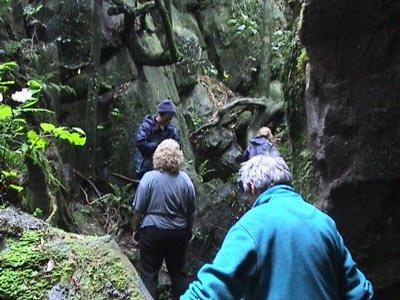Of Many Journeys and Strange Sites
Caves, shipwrecks and stone structures
Various ferret traps marked the climb to the top of Rarewarewa and possum bait stations. We were in a Kiwi restoration reserve, where DOC was carrying out an extensive program to help Kiwi to re-establish. The hill of Rarewarewa is covered by re generating bush and is isolated from the predations of feral cats and dogs.
This was the latest in a series of journeys to Northland in the past four weeks that includes caves, shipwrecks and stone structures.

We were a party of six, and we had come to this remote place to investigate a number of stone structures that had been reported many years ago by a local farmer. The ridge climb was easy going and thru track marked by the festive colors of plastic ribbons marking various bait trails. The forest was strangely devoid of bird sound, and the southwesterly air stream rattled the treetops. As we neared the top of the 1000ft high hill, we started to see the first of the many rock outcrops the formed part of the mystery of this place. We topped the crest of the hill and stepped up to a very flat area. To the left was the first of a number of stone structures, well tumbled by weather and years of wandering cattle.
And then, we were walking into a forest of towering, red barked trees some more than six feet around.
The sacred Totara stood in soaring majesty, from root bound soil to the first branch, a height of more than 30 feet. I stopped and looked around to discover and endless procession of these magnificent trees rooted among and over a bewildering array of tumbled and standing stone features. We were truly standing in the midst of a Castle in the Sky.
The Totara, anchored on the top of the mountain, reached to the sky, unseen through the canopy of green-branched heads. Noel estimated the age of the giant trunks as more than 350 years old. Looking at the number of trees that had rooted over stone heaps gave a broad indication of when people would have last used this place.
Local Iwi attach no history to this site, and know nothing of the people that would have lived here.
Before ascending the mountain, we had surveyed a village site on the lower slopes that would have provided water and arable cropping land. This place is far removed from the nearest river, and many miles inland from the coast. The vast swamplands lying to the North would have provided a source of Tuna or eel.
We then proceeded to the south along the flat hilltop, walking over and around many stone heaps.
Could this be the remains of a pit dwelling?
Within 50 meters we came across the first major construction. A deep ditch ran across the width of the top. The most interesting feature was the 6 ft. high retaining wall along the width of the excavation. Built from available stone, stacked amid sloping back at the top. Climbing across this barrier, we were soon to see 5 rectangular pits, one of which had a stacked stonewall along one side. A most unusual feature, as there was more than enough ground space to have dug a conventional “kumara storage pit”. Could this be the remains of a pit dwelling, a method of construction reported over the years, but often written off as storage pits?
Walking to the southern extremity of the site we discovered a massive stacked stonewall that served to build and fortify this end of the site. The stones were well placed and fitted, although the deprivations of time and the feet of many cattle had reduced much to a heap of rubble.
The young reporter that had joined us for the day was making notes and taking photographs for an article in a local Whangarei newspaper. This was a new topic for her, and she was full of questions, many of which can only be answered when we carry out an in depth site analysis at a later date.
Our party was made up of a number of experienced “amateur” historians including Noel Hilliam from Dargaville.
Over the past 20 years Noel and I have shared a number adventures in and around these northern regions.
From coastal shipwrecks to stone structures and intriguing landscape features, we have had many wonderful experiences together and observed much in our endeavor to establish satisfactory evidence to support claims that there was a vast population throughout the islands of New Zealand that preceded the arrival.
